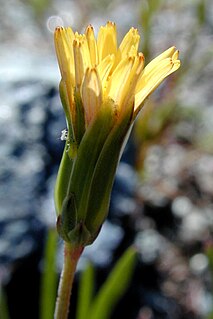
Microseris douglasii is a species of flowering plant in the aster family known by the common name Douglas' silverpuffs. It is native to western North America from Oregon and California to Baja California. It grows in several types of habitat, including grassland and vernal pools, and on soils containing clay and serpentine.
Pseudobahia bahiifolia is a rare species of flowering plant in the aster family known by the common name Hartweg's golden sunburst.
Pseudobahia peirsonii is a rare species of flowering plant in the aster family known by the common names San Joaquin adobe sunburst and Tulare pseudobahia. It is endemic to California, where it is known from a few mostly small occurrences along the southeastern side of the San Joaquin Valley where it rises into the Sierra Nevada foothills. It grows in grassland and oak woodland habitat. It prefers heavy adobe clay soils. The plant became a federally listed threatened of the United States in 1997.
Raillardella argentea is a species of flowering plant in the aster family known by the common name silky raillardella. It is native to the Sierra Nevada and nearby mountain ranges of California, its distribution extending east into Nevada and north along the Cascade Range and Klamath Mountains into Oregon. It grows in many types of dry, open mountain habitat. It is a rhizomatous perennial herb growing in a clump of rosetted basal leaves. The leaves are lance-shaped, up to 8 centimeters long, and coated in silky hairs. The plant produces an inflorescence up to about 15 centimeters tall consisting of a solitary flower head which is cylindrical to somewhat bell-shaped. The head is enclosed in the fused outer scales of the flowers, which look similar to the phyllaries of many other species' flower heads. The head contains many yellow disc florets up to a centimeter long each, and no ray florets. The fruit is a long, narrow achene which may be 2 centimeters in length including its plumelike pappus.

Raillardella pringlei is an uncommon species of flowering plant in the aster family known by the common name showy raillardella. It is endemic to the southern Klamath Ranges of northern California, where it grows in moist forest habitat on serpentine soils. It is a rhizomatous perennial herb growing in a clump of rosetted basal leaves. The leaves are linear to lance-shaped with smooth or faintly toothed edges, up to 15 centimeters long, and mostly hairless. The plant produces an inflorescence generally 25 centimeters to half a meter tall consisting of a solitary flower head or an array of up to three heads. The head is bell-shaped, sometimes widely so. It contains many orange to red-orange disc florets each about a centimeter long, and a fringe of several orange or reddish ray florets each up to 2 centimeters in length. The fruit is a long, narrow achene which may be 2 centimeters in length including its pappus of plumelike bristles.
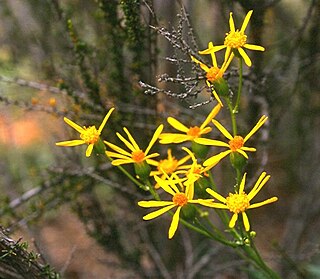
Packera layneae, known by the common name Layne's ragwort and Layne's butterweed, is a rare species of flowering plant in the aster family.
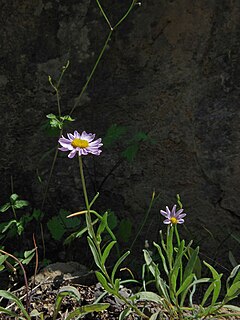
Erigeron maniopotamicus is a rare species of flowering plant in the aster family known by the common name Mad River fleabane. It is endemic to northwestern California, where it is known from only four locations in Humboldt and Trinity Counties.

Chrysopsis floridana is a rare species of flowering plant in the aster family, known by its common name, Florida golden aster. It is endemic to Florida in the United States, where it is known from Hillsborough, Hardee, Manatee, and Pinellas Counties. It is considered an endemic of the west-central coast of the state in the general vicinity of Tampa Bay. There are 17 to 20 occurrences, many of which have few individuals, but one of which has over one million plants. In 1986 the plant was added to the US endangered species list because it was becoming increasingly rare, it was growing only on private property, and its habitat was unprotected and being destroyed and degraded by a number of forces. It is found at Bell Creek Nature Preserve in Riverview, Florida.

Deinandra conjugens is a rare species of flowering plant in the aster family known by the common names Otay tarplant and Otay tarweed. It is native to a small section of far northern Baja California in Mexico, its range extending north into San Diego County, California, in the United States. One isolated population has been reported from the hills east of Cayucos in San Luis Obispo County.

Erigeron rhizomatus is a rare species of flowering plant in the aster family known by the common names Zuni fleabane and rhizome fleabane. It is native to western New Mexico and eastern Arizona in the United States. It is a federally listed threatened species.

Pityopsis ruthii is a rare species of flowering plant in the aster family known by the common name Ruth's golden aster. It is endemic to the US state of Tennessee, where it is known only from Polk County. It is threatened by the modification of its habitat. It is a federally listed endangered species.
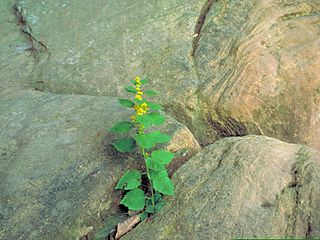
Solidago albopilosa is a rare species of flowering plant in the aster family known by the common name whitehair goldenrod.
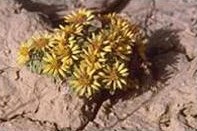
Townsendia aprica is a rare species of flowering plant in the aster family known by the common name Last Chance Townsend daisy. It is endemic to Utah in the United States, where it is known from three counties. It faces a number of threats and it is a federally listed threatened species of the United States.

Eucephalus vialis is a rare North American species of flowering plant in the aster family known by the common name wayside aster. It is native to southwestern Oregon and northwestern California in the United States.
Senecio ertterae is a species of flowering plant in the aster family known by the common name Ertter's ragwort. It is endemic to Oregon in the United States.
Solidago verna is a species of flowering plant in the aster family known by the common names springflowering goldenrod and spring goldenrod. It is native to North Carolina and South Carolina in the United States.
Thelesperma pubescens is a species of flowering plants in the aster family known by the common names hairy greenthread and Uinta greenthread. It is native to Wyoming and Utah in the United States. This species was first described in 1983.

Cirsium perplexans is a species of flowering plant in the aster family known by the common names Rocky Mountain thistle and Adobe Hills thistle. It is endemic to Colorado in the United States, where it occurs in the Colorado and Gunnison River Valleys in the Rocky Mountains.

Xanthisma coloradoense is a species of flowering plant in the aster family known by the common name Colorado tansyaster. It is native to Colorado and Wyoming in the United States.

Symphyotrichum georgianum is a rare species of flowering plant in the Asteraceae, the aster family. Its common name is Georgia aster. It is native to the southeastern United States, where it is known from Alabama, Florida, Georgia, North Carolina, and South Carolina. Today it may be extirpated from the state of Florida.















